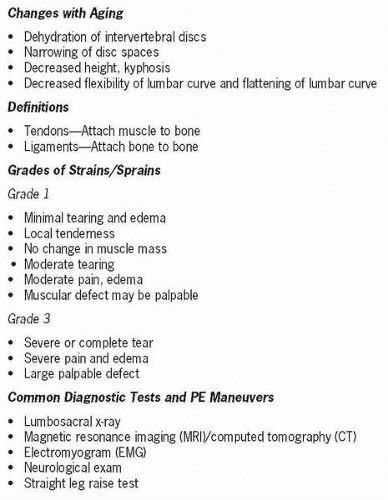Low Back Pain
Low back pain of musculoskeletal origin is one of the most common causes of pain in adults and results in significant loss of work hours. Although it is sometimes caused by acute injury, it is commonly chronic and often caused by soft tissue strain, sprain, or overuse due to muscle weakness, deconditioning, obesity, poor body mechanics, or poor posture. It may be accompanied by sciatica in which pain occurs along the distribution of one or both sciatic nerves. Other musculoskeletal or neurological conditions can also cause low back pain, such as degenerative disc disease, arthritis, herniated nucleus pulposus (herniated disk), fibromyalgia, bursitis, radiculitis, fibrosis, stenosis, and vertebral fracture. Ninety percent of acute low back problems resolve spontaneously within 4 weeks, regardless of treatment.
The vertebral column is supported by a complex group of strong serially arranged muscles, fascia, and ligaments that extend from the skull to the pelvis. Functionally, these serve as a single muscle and maintain extension of the vertebral column. These structures work in conjunction with those of the abdomen, thorax, pelvis, neck, and head
to afford the trunk full range of motion. The muscles of the abdomen are particularly important in providing additional support to the back. Imbalance between abdominal and back muscles promotes transfer of weight bearing from the anterior spine to the posterior spine, causing muscle spasm and low back pain.
to afford the trunk full range of motion. The muscles of the abdomen are particularly important in providing additional support to the back. Imbalance between abdominal and back muscles promotes transfer of weight bearing from the anterior spine to the posterior spine, causing muscle spasm and low back pain.
Vertebral joints are classified as amphiarthroses, or partially moveable joints. The intervertebral discs are pad-like structures between the vertebrae that help stabilize them and act as shock absorbers between them. They also help to maintain the normal spinal curvatures. The outer layer of the disc is a tough, fibrous layer referred to as the annular layer. The inner portion is more viscid and is called the nucleus pulposus. It lies close to the posterior portion of the disc. The nucleus pulposus changes shape with spinal movement, causing bulging of the annulus. The discs are strongly attached to adjacent vertebral bodies. They are a common cause of back pain. Because of their high water content, the discs are subject to dehydration as people age, resulting in thinning of the discs, a decrease in shock absorbency, less spinal stability, and less ability to tolerate stress and strain.
Stay updated, free articles. Join our Telegram channel

Full access? Get Clinical Tree




